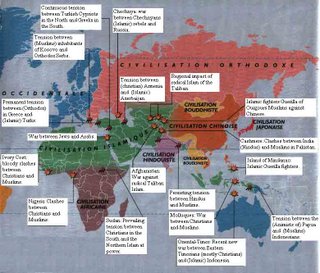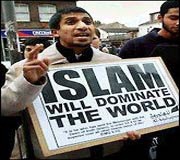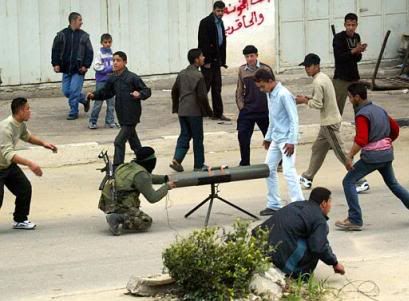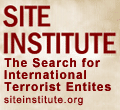Madrassa: Breeding ground of Jihadists
Modern Ghana - Mar 30, 2009 By Salah Uddin Shoaib Choudhury
When I for the first time forecasted that Madrassa was becoming breeding ground of Jihadists, many of my fellow journalists instantly raised their fingers at me saying, I was serving the purpose of ‘foreign interest’. Policymakers in the government were even much aggressive in bringing sedition, treason and blasphemy charges against me. They tried to give justification to such actions saying, my criticizing the Madrassa and forecasting the rise of Islamist militancy within such institutions; I was hurting the sentiment of Muslims and was doing harm to Islam!
Ridiculous indeed!
In this article, I will discuss many of the unknown and untold facts on Madrassas in the world, along with some very exclusive investigative information on such religious schools.
Muslims consider Madrassas as the basic place of generating clergies as well as those who can be the custodians of Islam in the respective countries. But, many are still unaware that in the name of religious education, major segment of such Madrassas are active as breeding ground of Jihadists. Instead of real Islamic education, the students are taught of religious hatred. Their brains are filled with the poison of hate towards everyone who is not a Muslim. Moreover, the very old notion of ‘killing Jews and Christians’ and remaining a good Muslim is very strong planted in the minds of thousands of students of such institutions.
For past several years, I have done extensive investigation into the Madrassa education system and the Qaomi [Koranic] Madrassa in Bangladesh as well as studied extensively on such religious schools around the world and each of my inquisitive investigations finally ended in identifying growth of radical and militant Islam right within the 64,000 Qaomi Madrassas in Bangladesh, as well others within the Islamic and non Islamic world.
Although people are always putting focus on Madrassas involvement in breeding Jihadists, they are yet to investigate the inside stories in Madrassas, where male and female students are sexually abused by the clergies on a regular basis. Sodomy is a growing phenomenon in the Madrassas, and according to various reports, silent spread of HIV and Aids is gradually putting a huge blanket on the large number of students and teachers coming of such institutions.
Terrorism and rise of radical Islam is a global problem. Islamic terrorism [also known as Islamist terrorism or Jihadist terrorism] is religious terrorism by those whose motivations are rooted in their interpretations of Islam. Statistics gathered for 2006 by the National Counterterrorism Center of the United States indicated that “Islamic extremism” was responsible for approximately 25% of all terrorism fatalities worldwide, and a majority of the fatalities for which responsibility could be conclusively determined. Terrorist acts have included airline hijacking, beheading, kidnapping, assassination, roadside bombing, suicide bombing, and occasionally rape.
According to some experts, Perhaps the most resonant incident of Islamic terrorism was the 9/11 attack on the United States. Other prominent attacks have occurred in Iraq, Afghanistan, India, Israel, Britain, Spain, France, Russia and China. These terrorist groups often describe their actions as Islamic jihad [struggle]. Self-proclaimed sentences of punishment or death, issued publicly as threats, often come in the form of fatwas [Islamic legal judgments]. Both Muslims and non-Muslims have been among the targets and victims, but threats against Muslims are often issued as takfir [a declaration that a person, group or institution that describes itself as Muslim has in fact left Islam and thus is a traitor]. This is an implicit death threat as the punishment for apostasy in Islam is death under Sharia law.
The controversies surrounding the subject include whether the terrorist act is self-defense or aggression, national self-determination or Islamic supremacy; the targeting of noncombatants; whether Islam ever could condone terrorism; whether some attacks described as Islamic terrorism are merely terrorist acts committed by Muslims or nationalists; how much support there is in the Muslim world for Islamic terrorism; whether the Arab-Israeli Conflict is the root of Islamic terrorism, or simply one cause.
Osama bin Laden is the millionaire son of a construction magnate. Ayman al-Zawahiri, Bin Laden’s deputy, is a medical doctor. Abu Musab al-Zarqawi, the leader of Al Qaida in Iraq was an uneducated street thug who converted to a radical form of Islam in prison. Recently we saw a female Belgian convert to Islam become a suicide bomber in Iraq. It is difficult to identify what such people have in common other than a willingness to kill — and sometimes to die — for a cause they are convinced is right. No study has so far been able to explain why some people become terrorists and others don’t. Socio-psychological factors and questions of identity seem to be important and the dynamics of various cults have some striking parallels to terrorist cells. One thing we frequently see in the trajectory of terrorists is a conversion experience that occurs within a small, tight-knit group. The dynamics of such groups tend to reinforce personal conviction, especially among individuals whose other social networks have frayed or can’t match the intensity of bonds forged in what is for them an existential struggle.
Often the group is led by a ‘charismatic figure’ such as a ‘jihad veteran’, or jihad entrepreneur who raises funds and recruits for jihad. Such groups are found in many contexts, from prisons to social clubs. Often they are associated with a mosque, but generally they do not hold meetings in the mosque itself. Also the internet is playing a role in this conversion by exposing people to extremist views and the possibilities presented by jihad.
Many of the members of such cells have little history of extremism — or of piety. The most pious are not necessarily those most likely to become terrorists. Indeed, one could argue that for some people it is their poor understanding of Islam — and for the young suicide bomber, perhaps even their naivety — that has made them susceptible to extreme views.
Some analysts have argued that the root causes of terrorism lie not with the psychology or life experience of the individual but with deeper underlying political and economic currents. These root causes are variously listed as poverty, underdevelopment, un-employment, the demography of youth bulges, Palestinian dispossession and so forth.
These so-called ‘root causes’ are relevant but they do not go to the heart of the issue. First, there is the obvious fact that many terrorists are middle class or even from elites. Social studies of terrorists show that they are generally better educated than the broader population.
Secondly, terrorism is not limited to developing countries: look at the history of terrorism in developed democracies such as the United Kingdom. Finally, behind talk of root causes there is an assumption that they are somehow more real than the terrorists’ self-proclaimed motivations, that economic factors are more solid than ideology or identity. But as the protests over the Danish cartoons showed: issues of belief, identity and culture are just as real as material ones for many Muslims, and may well drive the emotions of many even more strongly.
That said, dysfunctional economies and authoritarian political systems magnify feelings of frustration and anger which, in turn, provide fertile soil for those who manipulate questions of identity and victim hood in the cause of violent jihad.
Since 9/11 the nature of the terrorist threat has changed. It has become more decentralized and amorphous. Al Qaida is still an active threat even if it has not been directly responsible for any major attack for the past two years. Al Qaida is fighting a war that it believes will last for generations. It has not given up its goal of conducting catastrophic attacks in the United States. We should not forget that eight and a half years passed between the first and second World Trade Centre attacks, and that the relative failure of the first attack seems to have acted more as an incentive than a dampener.
One of Al Qaida’s ‘achievements’ has been to draw many groups and Jihadists out of their local struggles and focus them on the ‘far enemy’. Zawahiri, now Al Qaida’s chief ideologist, himself moved from a local, Egyptian preoccupation to a global, anti-US ideology. And the story of Jamaah Islamiyah in Indonesia is about the transformation of a group which grew out of a national Islamist movement — Darul Islam — and has gone on to adopt the global Jihadist view of Al Qaida and others.
The terrorist threat today is best understood as a network of networks.
Sometimes the groups and cells that make up this extended network are held together by formal alliances — the best example is the alliance between core Al Qaida and Abu Musab al-Zarqawi’s Al Qaida franchise in Iraq. But most often the links are informal, based on personal contacts. Surprising to some as it may seem, Al Qaida does not exercise command and control over this extensive network. Continued
Madrassa: Breeding ground of Jihadists
Modern Ghana - Mar 30, 2009 By Salah Uddin Shoaib Choudhury
When I for the first time forecasted that Madrassa was becoming breeding ground of Jihadists, many of my fellow journalists instantly raised their fingers at me saying, I was serving the purpose of ‘foreign interest’. Policymakers in the government were even much aggressive in bringing sedition, treason and blasphemy charges against me. They tried to give justification to such actions saying, my criticizing the Madrassa and forecasting the rise of Islamist militancy within such institutions; I was hurting the sentiment of Muslims and was doing harm to Islam!
Ridiculous indeed!
In this article, I will discuss many of the unknown and untold facts on Madrassas in the world, along with some very exclusive investigative information on such religious schools.
Muslims consider Madrassas as the basic place of generating clergies as well as those who can be the custodians of Islam in the respective countries. But, many are still unaware that in the name of religious education, major segment of such Madrassas are active as breeding ground of Jihadists. Instead of real Islamic education, the students are taught of religious hatred. Their brains are filled with the poison of hate towards everyone who is not a Muslim. Moreover, the very old notion of ‘killing Jews and Christians’ and remaining a good Muslim is very strong planted in the minds of thousands of students of such institutions.
For past several years, I have done extensive investigation into the Madrassa education system and the Qaomi [Koranic] Madrassa in Bangladesh as well as studied extensively on such religious schools around the world and each of my inquisitive investigations finally ended in identifying growth of radical and militant Islam right within the 64,000 Qaomi Madrassas in Bangladesh, as well others within the Islamic and non Islamic world.
Although people are always putting focus on Madrassas involvement in breeding Jihadists, they are yet to investigate the inside stories in Madrassas, where male and female students are sexually abused by the clergies on a regular basis. Sodomy is a growing phenomenon in the Madrassas, and according to various reports, silent spread of HIV and Aids is gradually putting a huge blanket on the large number of students and teachers coming of such institutions.
Terrorism and rise of radical Islam is a global problem. Islamic terrorism [also known as Islamist terrorism or Jihadist terrorism] is religious terrorism by those whose motivations are rooted in their interpretations of Islam. Statistics gathered for 2006 by the National Counterterrorism Center of the United States indicated that “Islamic extremism” was responsible for approximately 25% of all terrorism fatalities worldwide, and a majority of the fatalities for which responsibility could be conclusively determined. Terrorist acts have included airline hijacking, beheading, kidnapping, assassination, roadside bombing, suicide bombing, and occasionally rape.
According to some experts, Perhaps the most resonant incident of Islamic terrorism was the 9/11 attack on the United States. Other prominent attacks have occurred in Iraq, Afghanistan, India, Israel, Britain, Spain, France, Russia and China. These terrorist groups often describe their actions as Islamic jihad [struggle]. Self-proclaimed sentences of punishment or death, issued publicly as threats, often come in the form of fatwas [Islamic legal judgments]. Both Muslims and non-Muslims have been among the targets and victims, but threats against Muslims are often issued as takfir [a declaration that a person, group or institution that describes itself as Muslim has in fact left Islam and thus is a traitor]. This is an implicit death threat as the punishment for apostasy in Islam is death under Sharia law.
The controversies surrounding the subject include whether the terrorist act is self-defense or aggression, national self-determination or Islamic supremacy; the targeting of noncombatants; whether Islam ever could condone terrorism; whether some attacks described as Islamic terrorism are merely terrorist acts committed by Muslims or nationalists; how much support there is in the Muslim world for Islamic terrorism; whether the Arab-Israeli Conflict is the root of Islamic terrorism, or simply one cause.
Osama bin Laden is the millionaire son of a construction magnate. Ayman al-Zawahiri, Bin Laden’s deputy, is a medical doctor. Abu Musab al-Zarqawi, the leader of Al Qaida in Iraq was an uneducated street thug who converted to a radical form of Islam in prison. Recently we saw a female Belgian convert to Islam become a suicide bomber in Iraq. It is difficult to identify what such people have in common other than a willingness to kill — and sometimes to die — for a cause they are convinced is right. No study has so far been able to explain why some people become terrorists and others don’t. Socio-psychological factors and questions of identity seem to be important and the dynamics of various cults have some striking parallels to terrorist cells. One thing we frequently see in the trajectory of terrorists is a conversion experience that occurs within a small, tight-knit group. The dynamics of such groups tend to reinforce personal conviction, especially among individuals whose other social networks have frayed or can’t match the intensity of bonds forged in what is for them an existential struggle.
Often the group is led by a ‘charismatic figure’ such as a ‘jihad veteran’, or jihad entrepreneur who raises funds and recruits for jihad. Such groups are found in many contexts, from prisons to social clubs. Often they are associated with a mosque, but generally they do not hold meetings in the mosque itself. Also the internet is playing a role in this conversion by exposing people to extremist views and the possibilities presented by jihad.
Many of the members of such cells have little history of extremism — or of piety. The most pious are not necessarily those most likely to become terrorists. Indeed, one could argue that for some people it is their poor understanding of Islam — and for the young suicide bomber, perhaps even their naivety — that has made them susceptible to extreme views.
Some analysts have argued that the root causes of terrorism lie not with the psychology or life experience of the individual but with deeper underlying political and economic currents. These root causes are variously listed as poverty, underdevelopment, un-employment, the demography of youth bulges, Palestinian dispossession and so forth.
These so-called ‘root causes’ are relevant but they do not go to the heart of the issue. First, there is the obvious fact that many terrorists are middle class or even from elites. Social studies of terrorists show that they are generally better educated than the broader population.
Secondly, terrorism is not limited to developing countries: look at the history of terrorism in developed democracies such as the United Kingdom. Finally, behind talk of root causes there is an assumption that they are somehow more real than the terrorists’ self-proclaimed motivations, that economic factors are more solid than ideology or identity. But as the protests over the Danish cartoons showed: issues of belief, identity and culture are just as real as material ones for many Muslims, and may well drive the emotions of many even more strongly.
That said, dysfunctional economies and authoritarian political systems magnify feelings of frustration and anger which, in turn, provide fertile soil for those who manipulate questions of identity and victim hood in the cause of violent jihad.
Since 9/11 the nature of the terrorist threat has changed. It has become more decentralized and amorphous. Al Qaida is still an active threat even if it has not been directly responsible for any major attack for the past two years. Al Qaida is fighting a war that it believes will last for generations. It has not given up its goal of conducting catastrophic attacks in the United States. We should not forget that eight and a half years passed between the first and second World Trade Centre attacks, and that the relative failure of the first attack seems to have acted more as an incentive than a dampener.
One of Al Qaida’s ‘achievements’ has been to draw many groups and Jihadists out of their local struggles and focus them on the ‘far enemy’. Zawahiri, now Al Qaida’s chief ideologist, himself moved from a local, Egyptian preoccupation to a global, anti-US ideology. And the story of Jamaah Islamiyah in Indonesia is about the transformation of a group which grew out of a national Islamist movement — Darul Islam — and has gone on to adopt the global Jihadist view of Al Qaida and others.
The terrorist threat today is best understood as a network of networks.
Sometimes the groups and cells that make up this extended network are held together by formal alliances — the best example is the alliance between core Al Qaida and Abu Musab al-Zarqawi’s Al Qaida franchise in Iraq. But most often the links are informal, based on personal contacts. Surprising to some as it may seem, Al Qaida does not exercise command and control over this extensive network….
http://www.modernghana.com/news/208749/1/madrassa-breeding-ground-of-jihadists.html
Tuesday, March 31, 2009
Madrassa: Breeding ground of Jihadists
Labels: Indoctrination, jihad, war on terror

































